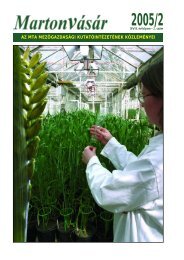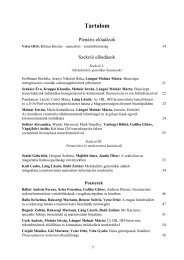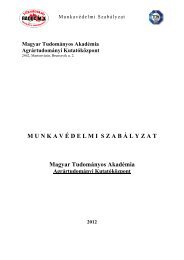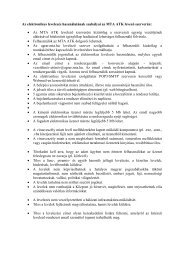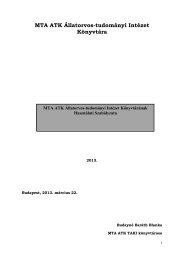buckwheat
buckwheat
buckwheat
Create successful ePaper yourself
Turn your PDF publications into a flip-book with our unique Google optimized e-Paper software.
Ribonuclease activity of<br />
uninfected and infected<br />
<strong>buckwheat</strong> plants of<br />
different varieties<br />
Yana R. Sindarovska - O.I. Lozova - L.V. Yuzvenko - L.F. Didenko -<br />
N.Ya. Spivak<br />
Institute of Cell Biology and Genetic Engineering, NASU and<br />
D.K. Zabolotny Institute of Microbiology and Virology, NASU
The areas of Fagopyrum<br />
esculentum (<strong>buckwheat</strong>)<br />
plants utilization<br />
• Honey plant<br />
• Boiled grains –<br />
traditional dish in<br />
some countries<br />
• Medical use: leaves<br />
are antioxidants;<br />
leaves and flowers<br />
can alleviate some<br />
specific diseases
The diseases of<br />
<strong>buckwheat</strong> plants<br />
• About 30 different pathogenic<br />
organisms affect <strong>buckwheat</strong> plants:<br />
• fungi (Реronоsроrа – mildew, Fusarium,<br />
Phytophthora, Erysiphe –powdery mildew),<br />
• bacteria (Pseudomonas syringae –<br />
bacteriosis)<br />
• and viruses (tobacco mosaic virus,<br />
<strong>buckwheat</strong> burn virus).<br />
)
Buckwheat burn virus<br />
• Buckwheat burn virus has<br />
negative-sense ss RNA<br />
genome and can be included<br />
into Rhabdoviridae id family.<br />
• The virus is a high virulent<br />
pathogen for <strong>buckwheat</strong>,<br />
potato, tomato, tobacco,<br />
pea, cucumber etc.<br />
• The virus can decrease<br />
<strong>buckwheat</strong> yields for up to<br />
80%.<br />
The more detail information about <strong>buckwheat</strong> burn virus you can also see on poster<br />
presentation “Properties of <strong>buckwheat</strong> burn virus” Yuzvenko L., Lozova O. et al.
Plant defense<br />
against viruses<br />
• Stress conditions change typical protein<br />
profile and trigger synthesis of pathogen-<br />
related proteins.<br />
• Nucleases are enzymes that hydrolyze nucleic<br />
acids. The level of ribonucleases (RNases) can<br />
increase greatly under stress conditions.<br />
• Buckwheat varieties have different sensitivity<br />
to <strong>buckwheat</strong> burn virus. The possible cause is<br />
different activity i of plant RNases.
The aim of work<br />
To analyze the correlation<br />
between RNase activity it and<br />
sensitivity of different<br />
<strong>buckwheat</strong> varieties to<br />
<strong>buckwheat</strong> burn virus
Experimental procedure<br />
• We used <strong>buckwheat</strong> varieties with different sensitivity<br />
to <strong>buckwheat</strong> burn virus: “Kara-Dag”<br />
– injured by<br />
virus, and “Roksolana” – slightly injured by virus.<br />
• Plants were infected by <strong>buckwheat</strong> burn virus.<br />
• The leaves were collected every 3 days after infection.<br />
• Total RNase activity was detected by decreased<br />
absorption at 260 nm.<br />
• Reaction mixture without added RNase was used as<br />
negative control. Reaction mixture added with RNase A<br />
served as positive control.
Uninfected <strong>buckwheat</strong><br />
plants of two varieties<br />
Absorp ption, А26 60<br />
1,6<br />
1,4<br />
12 1,2<br />
1<br />
0,8<br />
0,6<br />
0,4<br />
0,2<br />
"Roksolana" variety<br />
"Kara-Dag" variety<br />
0<br />
nega ative<br />
con ntrol<br />
RNa ase A<br />
4<br />
7<br />
10<br />
13<br />
16<br />
19<br />
Days after infection of plants<br />
High absorption value means low RNase activity, and vice versa.
Buckwheat plants of<br />
“Kara-Dag” variety<br />
Absor rption, А2 260<br />
1,6<br />
1,4<br />
1,2<br />
1<br />
0,8<br />
06 0,6<br />
0,4<br />
0,2<br />
uninfected plants<br />
infected plants<br />
0<br />
ne egative<br />
co ontrol<br />
RN Nase A<br />
4<br />
7<br />
10<br />
13<br />
16<br />
19<br />
Days after infection i of plants<br />
It was supposed that because of instable RNase activity especially during<br />
It was supposed that because of instable RNase activity especially during<br />
the first week “Kara-Dag” variety is injured by <strong>buckwheat</strong> burn virus.
Buckwheat plants of<br />
“Roksolana” variety<br />
Absorpti ion, А260 0<br />
1,6<br />
1,4<br />
12 1,2<br />
1<br />
0,8<br />
0,6<br />
0,4<br />
0,2<br />
uninfected plants<br />
infected plants<br />
0<br />
neg gative<br />
con ntrol<br />
RN Nase A<br />
4<br />
7<br />
10<br />
13<br />
16<br />
19<br />
Days after infection of plants<br />
I d h b f hi h RN i i d i k h i<br />
It was assumed that because of high RNase activity during two weeks the virus<br />
invasion is restricted, so “Roksolana” is only slightly injured by <strong>buckwheat</strong> burn virus.
Conclusions<br />
• It was shown that <strong>buckwheat</strong> variety<br />
having less sensitivity to <strong>buckwheat</strong><br />
burn virus demonstrated in general<br />
higher RNase activity.<br />
• Thereby we assume that RNase<br />
activity level can be used as a test for<br />
sensitivity of different <strong>buckwheat</strong><br />
varieties to virus infection.
THANK YOU FOR<br />
YOUR ATTENTION!




